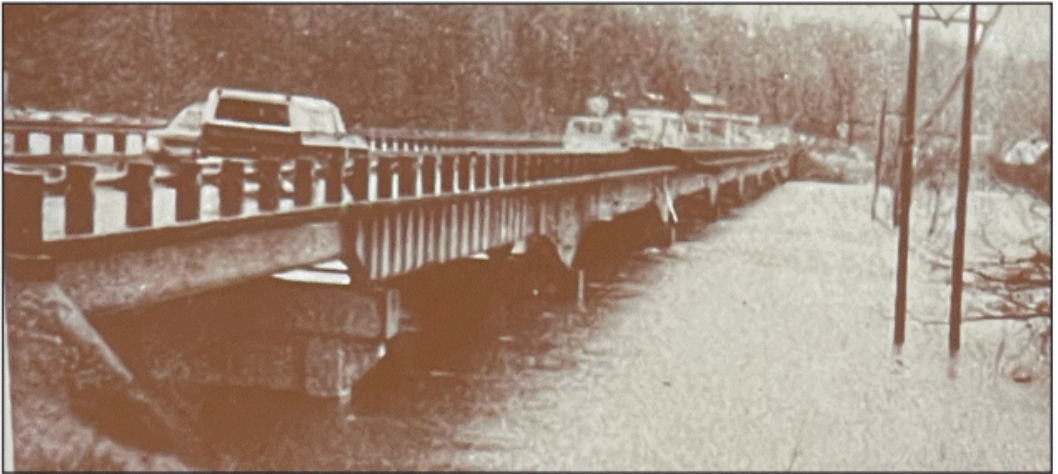Photo/Historical photo of 1982 Hardy flood from Spring River Times James Bates
The Spring River Bridge at Hardy on Dec. 2 1982 during the flood. The river rose a few inches higher before it crested after receiving 13 inches of rain in a 12 hour period.
By: Tammy Curtis, Managing Editor
The people of Hardy are no strangers to the wrath of Mother Nature, when the normally scenic Spring River quickly outpours her banks during massive rainfalls. The largest flood in the area occurred forty years ago On Dec. 2, 1982 and with it, took the old steel bridge that many remember jumping from as a child. Few residents who lived in Hardy, Highland and Cherokee Village forty years ago can ever recall a worse few days in weather history.
Just one day prior to the anniversary of the Great Hardy flood and Highland tornado, a large group gathered at the Hardy Gym to reflect on their memories of the flood and its impact on the area. The Hardy History Association hosted their monthly meeting with discussion and presentation about the floor.
Prior to 1982, historical documentation indicates the Great Flood of 1927 was the most destructive and costly flood in Arkansas history and one of the worst in the nation.
A slide show of old newspaper articles from the Spring River Times and photos was hosted by Nanette Daughtery. Andy Jackson, who lives in his father’s cabin on the banks of the river at Many Islands, was the first to speak. He told two stories from his neighbor and friends accounts of the night of the flood.
Jack Dawson, who was his neighbor and had built an octagon cabin on the river with a feeder creek that backs up during heavy rain. He said the night of the flood, the couple were downstairs and went upstairs for bed and his wife, Cybil, walked downstairs and tole her husband the cabin is flooding and going to “go”. She told him they needed to seek safety, and Jack refused, “If it goes I will go with it,” he proclaimed. Cybil, on the other hand, sought safety in a nearby cabin on higher ground. The river blew out their lower windows and washed their furniture out. A few day later as NAEC was restoring power, they found a coffee table they told them they felt belonged to them. “They go up there and it is their coffee table. It had Cybil’s purse on it, his wallet, both of their keys, their drinks and both of their cards from playing Gin Rummy… Nothing was scathed. It was all still on the table. They lost both of their vehicles.
Jackson explained that he had been on the phone reliving the accounts of Naomi Begalske,who had just been elected the first female mayor of Hardy and her husband, Richard who lived in the house above the river when the flood took away the old steel bridge. They had just received news about the tornado that just happened that evening destroying nearly 40 businesses at Highland. As they were in their storm cellar for the first time, the torrential rainfall began. Richard had “his prized pontoon” cabled to a tree down on the river and went down to pull it closer to the bank to prevent it from floating away. When he arrived at the bank, he was standing on dry land and his hand became pinned to the tree. “All of a sudden he looks down and said, my feet were wet, then my ankles were wet. The river started coming up so fast, I started panicking. I was stuck. Something happened, I got some slack in it, I jerked my hand out and ran up to Naomi and instructed her to draw all the water she could because they were going to lose the bridge.” He then went down to help James McKnight as he was stacking his furniture as the water is up to his ankle. The river was rising about six inches a minute. When they left the cabin it was up to their waist. Between 11 and midnight, they went to the Begalske’s as their home sat safely atop the hill. “They could hear stuff hitting the bridge and it was creaking. They said it was the scariest sound they have ever heard. It was a sad sound too, because they knew the bridge was going to go. Finally, they heard a big boom, the bridge came up and hit the wires above it and lit up the sky like a fireworks show. The bridge then came up like the Titanic then they saw it go down the river. They knew they were out of luck. They were on the South side of Hardy and knew they didn’t have any water.” The Begalske’s ended up putting up a temporary line cemented to the bottom of the river bed. Less than three weeks later, On Dec. 23 a hundred year flood came and they lost water again.
Milton Kelly had hydraulics and winches and utilized a two inch plastic water line and wrapped with cable and took it across the river in boats and strung it in trees with winches. For two years South Hardy was fed by that line until the new bridge was build in 1984 and it never froze. Naomi said the best thing to come out of the flood was that the fishing was the best in history.
Penny Hadley told a story from the Spring River Times of Raymond and Kathy Hicks son’s cocker spaniel, Blossom. In Rio Vista Two, where the South Fork River meets the Spring River, the dog was credited with saving the lives of his family and the neighbors. While nine homes were destroyed in the flood in Rio Vista, the Hicks home was spared. Dorothy Evans called in the early morning hours telling Kathy and her family to get out as the river was rising. A few minutes later, Dorothy’s husband Otho called and reminded them not to forget Blossom as he had awakened them. Blossom was at the downstairs door scratching standing in the Southfork River, that is typically 400 feet below the home after she likely had floated up from her pen. The river missed getting in their upper level of their home by three inches. Homes that had got stuck in the flooded Southfork landed in the Evans yard, while others became trapped on the large Hardy Bridge, including the home of Dick Harris’ that sat on the North Golf Course in Cherokee Village.
Garry Lawrence recalled the night of the flood as he was living on Wahpeton Hill and was married to a woman who worked as a telephone operator at Centurytel. She called to tell him she couldn’t get home due to the rising river. She looked out to see the rising water and called the manger and asked him to move the trucks out of the yard late that night. The reality of the water getting that high wasn’t something they took seriously. “They sat and watched the water rise above the trucks and as they did, it shorted the batteries out and all the lights on the trucks were on.” The operators couldn’t leave and were rescued by boats the next morning. He said the National Guard was brought in during the tornado at Highland.
Retired Arkansas State Police Sgt. Mack Thompson explained that he was the only law enforcement officer who worked both the 1982 and 2006 tornadoes and floods. He recalled the night of the 1982 flood being on vacation and at Imboden with his Sergeant Don Coggin and family having a fish fry. Former Sheriff Sonny Powell, who was working his first year as sheriff, called, informing him that Highland had been wiped out by the tornado. Thompson helped to try to keep looters out of the Radio Shack and jewelry store that had been blown away while awaiting the National Guard to arrive.
One of the best stories Thompson told was of something that happened when he was told to go home because the Guard was arriving. Joel Mullins, his partner who worked with him at the State Police, had a received a call of an accident at Ravenden. Having to take a very long route through Ozark Acres and Newman Trail to respond, a man from out of town had run off into a flooded creek in his car and drowned. Mullins, who was on the State Police Dive Team, waded in and got him out and brought him on dry land to call for an ambulance to pick him up. “That wasn’t happening, there wasn’t any way for an ambulance to get to him. You have to understand, in 1982, we were still making things up as we went. There wasn’t any policy for things like this.” When asking Mullins what he did, Thompson said that he replied. “What could I do? I strapped him in the front seat, buckled him in and brought him to town.” He explained The rule was then if there wasn’t a policy against it, you can go ahead and do it. “I read that book and there wasn’t any policy about hauling dead people in the front seat.”
He also told about a house in Rio Vista Two that Mullins swam into in uniform to save a lady. He put her on a mattress and brought her out, saving her from drowning. “He never received mention or an award for it. He didn’t want it, that is the kind of guy he was.” He also shared his memories of coming down with Hap Wright and trying to make him happy by trying to help him prevent kids from jumping off the old bridge into the river. Thompson said extra registers were set up at an Ash Flat grocery store to help with the influx of customers because there was no place to buy groceries in Hardy, because the Town and Country was under water.
Jan Lusk, whose parents lived in Hardy, in the current location of Century 21 on the night of the tornado and flood told of her memories. Lusk went tostay with her parents due to the tornado at Highland, where she and her family lived. She recalled her dad going into their downstairs garage to get things out of the basement. “He opened the basement door and it was absolutely pouring. He had that old box trailer and it had floated down blocking the culvert at the road. So I am thinking this is blocking and that is why water is coming into the basement.” She said she went upstairs and called for a wrecker to get the trailer. “We didn’t know the Spring River was flooding the basement. Needless to say, Daddy moved things up on cinder blocks in the house upstairs. It got at least a foot and a half in the main living part of the house.” She said he also owned a few boats. “He said last time he saw one of them it was heading down Main Street and took a right and you never saw it again,” Lusk laughed. She told how many bridges were closed including the Strawberry River Bridge over which she must cross to get to work at Evening Shade where she taught.
It is no surprise that the Arkansas Gazette would later describe this early December storm as the worst natural disaster in Arkansas’s history. It dumped about 13 inches of rain in a 12 hour period. 23 bridges washed out during the flood. Many of the businesses in Hardy were submerged or water was high in the buildings. The River was merely inches from crossing the highway on the new Hardy bridge, that has since been rebuilt.
Next week, we will focus on the history of the 1982 tornado.

